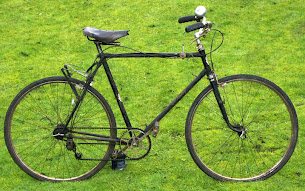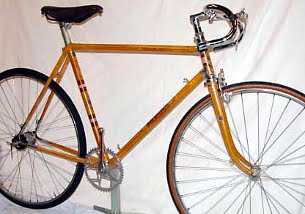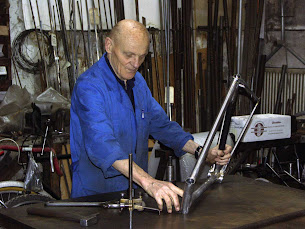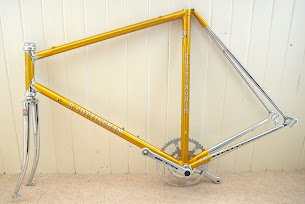Class Act
Hobbs of Barbican not only made some of the classiest frames and components (even if some of the latter could be a little delicate) during their distinguished history but, along with Rattray's "Flying Scot", could lay claim to having the best name as well !The company is believed to have been started by Albert Hobbs in the Barbican in the centre of London in 1930 but the earliest bike so far unearthed dates back to 1933. Hobbs was among a raft of firms that took advantage of the bike boom in the late 1920s and early 1930s but quickly distinguished themselves by the quality of their machines and the elegant and beautifully filed lugs they often used.
The "Barbican" in the Hobbs name comes from the Latin Barbecana meaning an outwork. Gradually the meaning changed, along with the pronunciation, to identify a fortified outpost or gateway.
In London, this Barbican was situated on the northern edge of what was Roman Londinium, a town of approximately 325 acres. The original Barbican of this period was probably sited somewhere between the northern side of the Church of St Giles Cripplegate and the YMCA hostel on Fann Street.
St Giles is associated with the Cripplegate entrance to the City of London but the word, Cripplegate, is a corruption of the Saxon word Crepel which means a covered way, in this case leading from the City Wall out to the Barbican. (The church of St Giles Cripplegate is thought to have had its origins at the end of the 11th century but was burned down around the middle of the 16th Century. The present building is one of the few churches to have survived the Great Fire of London in 1666.)
The original Hobbs of Barbican workshop was situated at 34 Barbican, EC2. In those pre-war days, this was a street and not part of the modern Barbican Centre. No. 34 was on the north side of Barbican and just west of the junction with Golden Lane. It is now the western part of Beech Street, EC2.
A firm called J. Hobbs and Son, dealers in trunk and bag fittings, were based at that address in the 1930s. Hobbs of Barbican were first mentioned in the trade directory of 1936 alongside J. Hobbs and Son. The bike makers continued to be listed up to and including 1941.
During the 1939-45 war the City of London and the Barbican area suffered appalling damage and loss of life. This area was home to many small businesses and was devastated during the Blitz. It is believed to be around this time that Albert Hobbs moved his operation to the Sterling Works at Dagenham with production up and running soon after the end of hostilities.
The former Barbican site was redeveloped and is now a mix of housing and commercial units. The Barbican Centre was part of the post-war restoration and covers the site of many small streets and the warehouses and workshops that formerly stood there
Outgunned
The Dagenham factory also housed the manufacturers of the Sterling machine gun but it was another gun, the Owen, that eventually forced the closure of Hobbs' framebuilding operation in the mid-1950s when the bike company's space was taken over for increased production of the weapon.Hobbs continued in business as a retailer and wholesaler but one of the great English names was
effectively lost. Hobbs used very few pictures of their frames in their brochures so it can be difficult with a frame that has lost its original transfers and paintwork to identify the model concerned.
 There was certainly quite a line-up over the 25 years or so of the marque's existence. In common with many framebuilders, the model range was in a fairly constant state of flux. The line-up changed regularly and attempting to catalogue the frames in ascending order of quality or price is little more than a snapshot of a given period. The most famous and highly sought after was the Blue Riband launched as part of a prototype range in 1948/49.
There was certainly quite a line-up over the 25 years or so of the marque's existence. In common with many framebuilders, the model range was in a fairly constant state of flux. The line-up changed regularly and attempting to catalogue the frames in ascending order of quality or price is little more than a snapshot of a given period. The most famous and highly sought after was the Blue Riband launched as part of a prototype range in 1948/49.These frames were built to order with the company's best framebuilders deployed in their construction. Handbuilt beauties, they were amongst the finest produced in post-war Britain. Hobbs' brochures reveal details of other models such as the Continental, Raceweight and Criterium with lugged and fillet-brazed (lugless) versions of most on offer.
Lytaloy
In addition to the frames, Hobbs also marketed a limited range of cycle components under the Lytaloy brand. Although these carried the Hobbs of Barbican name, many are thought to have been made for the company by sub-contractors. Finely finished and obviously well-engineered, they were amongst the more expensive bike parts around. The pedals and brakes were well regarded but the alloy chainset, although a light and classy bit of kit, is considered to be prone to breaking.
Other Lytaloy products included the headset which was specified by many other bike makers, too, brakes, mudguards and a light bracket. Many Hobbs bikes left the factory equipped with Lytaloy parts but the company also had a high opinion of BSA products and was happy to accommodate the plans of new owners.
The marque flared briefly again in the late 1960s/early 1970s when Hobbs commissioned another builder to produce a number of Blue Riband models with Prugnat spearpoint lugs but production was short-lived and rumours at the time suggested the company was simply trying to use up its stock of transfers!





